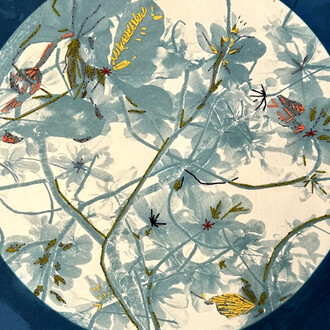Geary is pleased to present God of accidents, Tura Oliveira’s second solo exhibition with the gallery, on view from August 16 through October 5.
God of accidents is anchored by two large cyanotypes on red silk, installed with cast silver termites. The silk hangs dark and luminous; the cyanotypes are nearly black against the saturated red ground and the spiny, alien insects appear at various stages of metamorphosis, bearing a cast lamb’s hoof in place of a head. One quilt depicts a serpentine alien figure touching the forehead of a sleeping human; in the other, two figures cradle a shed or flayed skin.
Red and green checkered silk quilts echo the tiled floors of Renaissance Annunciation paintings, gridded thresholds where heaven breaches the domestic, an alien incursion heralded by light, voice, and shadow. Referencing Star trek and the sensuous violence of Italian Giallo cinema, God of accidents locates the Baroque in folds, ruptures, and proliferations that resist containment. Like the porous bodies of Cronenberg and Carpenter, Oliveira’s work approaches the Baroque not as ornament but as ontology: a condition of excess, a way of thinking through metamorphosis, rupture, and unstable flesh.
A small silver sculpture of a rabbit-like alien head rests on a red silk cushion, its neck severed, tentacles emerging from the wound. A memorial to the artist’s late pet rabbit, he is reimagined as a alien being returned to earth as a martyr. At the back of the gallery, bathed in red light, a silver reliquary bust conceals a miniature diorama visible only through a peephole. The scene, set in a decaying industrial zone, contrasts with the reliquary’s exterior, which writhes with barbed appendages, tentacles, and crab-like extrusions capped by lamb’s hooves. In Oliveira’s work, tentacles function as counter-appendages that reject the singular dominance of the eye or the hand, embodying a mode of sensing and thinking through touch, groping, brushing, and probing.
Pasolini argued that true sexual and social liberation cannot be bestowed from above, it must arise dal basso, from the subproletariat. Oliveira’s cast insects, decapitated martyrs, slithering aliens, and grasping tentacles take up this subaltern position: they are emissaries from the unconscious strata of the social body. The lamb, an early Christian symbol of purity, innocence, and submission, is fused with the insect: barbed, swarming, and abject. In this collision, Oliveira suggests a transformation not of spirit but of flesh, one that slithers out from under the martyr’s robes, trembling and blind, fumbling toward the light switch.
















